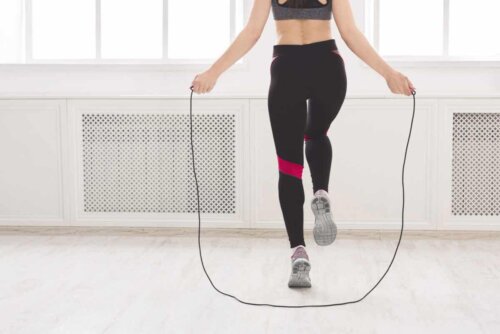Tips on How to Start a Vigorous Exercise Routine

There are three levels of exercise intensity: moderate, medium, and vigorous. Most people stick to the first two, whether they do aerobic or anaerobic activities. However, high-intensity routines are great for your health, so you should try them.
The main characteristic of this type of physical activity is the heart rate increases close to its maximum capacity. This is because it demands greater muscular endurance and strength. It significantly improves health overall, boosts fitness, and prevents and treats some common conditions when done regularly.
Today’s article contains everything you need to know about vigorous exercise — its pros, cons, and tips for safe, risk-free activity. Today’s information will definitely appeal to you if your body is asking you to increase the intensity!
What exactly is vigorous exercise?
High-intensity exercise is any activity that raises your heart rate to 70% or 85% of its maximum capacity. It’s, therefore, a type of aerobic exercise that involves lung capacity, endurance, and muscular strength in more demanding states.
According to the World Health Organization, the intensity of exercise is tied to the speed at which you do it. That is in the magnitude of the effort you exert to maintain and complete it. In this respect, high-intensity exercise raises the metabolic rate (METs) to a spectrum above 6. In turn, medium-intensity exercise raises it only from 3 to 6.
METs measure the intensity of an activity compared to a resting state. Thus, you’re exerting eight times more effort than you would at rest if it reaches 8 METs — climbing stairs at a brisk pace.
Some high-intensity exercises can be over 20 METs. For reference, 1 MET equals 0.0175 kcal. You can attain this value through the formula 0.0175 kcal x kilogram x minute of activity.
Check out these Sprinting Exercises to Improve Your Running Speed
Benefits of vigorous exercise
There’s been controversy surrounding vigorous exercise for a while. Some research, developed during the 20th century, suggested that high-intensity activities were detrimental to the heart, bones, and immune system. Scientists conducted some of those studies only on animals and extrapolated the results to humans.
Today we know that vigorous exercise has more advantages than risks, especially if you take into account several things before including it in your routine. At the end of this article, we’ll point out the most important ones. Let’s review some of its most notorious benefits first though.
1. Promotes weight loss
One of the main reasons people engage in physical activity is to lose body fat. Decades of studies reveal there’s an intrinsic relationship between weight loss and exercise. It all regardless of the level of intensity at which you perform it.
Despite this, the evidence suggests that the higher the intensity, the faster you can lose weight. Of course, the choice of activity must be personalized and take into account the previous physical and health conditions.

Read about The Health Impact of Anaerobic Exercises.
2. Control blood sugar levels
As mentioned above, any physical activity is good for controlling blood glucose. Research reveals that vigorous exercise helps regulate these values more effectively.
High-intensity activities will be your ally if there’s a history of diabetes in your family or you want to prevent it. Consult your specialist before starting this kind of routine if you already have it though.
3. It reduces deadly cardiovascular diseases
According to data from the World Health Organization, cardiovascular diseases are the leading cause of death worldwide. Estimates indicate that we can prevent 80% of myocardial infarctions and other similar problems that develop prematurely. The best ways to do this are physical activity and a balanced diet.
We often forget the heart is a muscle and, as such, we can strengthen it through exercise. Research shows how a vigorous exercise routine is better than a low or medium-intensity one to prevent heart disease and sudden death. Of course, its application is contraindicated in the presence of certain previous conditions. Also, you mustn’t do so without medical approval.
4. Increases bone density
A study published in 2005 suggests that high-impact physical activity is more effective in preventing and treating osteoporosis than low-intensity exercise. A routine of this type contributes to increasing bone mineral density to slow down the natural wear and tear that occurs after the age of 50.
Thus, vigorous exercise is particularly great for women, as they’re more prone to develop osteoporosis. However, you must also get into it if you are under 30 years old. This is because it’s still possible to attain the maximum bone density and maintain it during the later years of life up to this age range.
5. Control your blood pressure
According to data from the World Health Organization, 1 in 5 adults has high blood pressure. It causes 9.4 million deaths worldwide, so preventing or controlling it must be a priority.
Studies support the use of vigorous training to prevent and deal with high blood pressure levels. The use of moderate/high-intensity intervals in the routine leads to more effective results.
Check out an interval workout routine for beginners if you’re particularly interested in this topic. Also, consult your specialist before making any new changes if you have high blood pressure.
6. Regulates thyroid function
The debate is controversial but there’s evidence that high-intensity training is good for controlling thyroid hormone production. Remember that, irregular thyroid function can lead to depression, weight gain, and constipation, among other problems even if it’s asymptomatic in some contexts.
How to measure exercise intensity
There are several ways to include vigorous exercise in your workout routine. Fortunately, you can practice most disciplines, sports, and activities at a high intensity. You just need to modify the effort and magnitude.
Some of the methods you can use are:
- A heart rate monitor is a small instrument that allows you to measure your heartbeat. You already know your heart rate should be between 70% and 85% of your maximum frequency. Thus, you calculate it by subtracting 22o from your age and then multiplying the result by a value between 0.7 and 0.85.
- Taking the talk test is a little trick that lets you know how hard you’re exercising. You’re probably exercising at a high intensity if you can’t hold a fluent conversation when you exercise. In contrast, you’re training on a medium or low spectrum if you can.
- Measure it with the rate of perceived exertion, a subjective scale that measures the intensity of your workout from 1 to 10. You rate it based on your physical condition and the intensity of your past routines. Aim for an exertion value of between 7 and 9.

Tips for incorporating vigorous exercise into your routine
There are many exercises you can use to implement a vigorous routine into your day. Here are some of the most popular ones:
- High-intensity jogging
- Running
- Aerobics
- Jumping rope
- Bicycling at high intensity
- Swimming at a fast speed
- Soccer, rugby, basketball, and similar sports
Other types of activities, such as jumping fitness, body pump, spinning, and aerobic dance can also qualify as vigorous exercise if they meet the criteria outlined at the beginning.
Remember that all of these must raise your heart rate between 70% and 85%, either for the entire activity or in intervals to qualify as high-intensity. Ideally, you should practice them for 50 minutes and accumulate 150 minutes of activity in three sessions per week.
It isn’t necessary to focus only on one of them. You can mix and match them with other workouts you do regularly. The important thing is to accumulate the 150 minutes using the benchmark tips.
Valuable tips for vigorous exercise
You must take into account some key elements to avoid injuries or complications derived from inexperience before incorporating these into your routine. We recommend the following:
- Have a doctor assess your state of health by subjecting you to a stress test. This is to find out how your heart responds.
- Also consult them if you have a condition, such as diabetes, hypertension, or are pregnant.
- Don’t abruptly increase the intensity, especially if you’re only used to low-impact exercise. Do it progressively over several weeks.
- Stretch all muscle groups properly before you start.
- Wear appropriate clothing and shoes for the activity you’re doing.
- Skip a day between every session.
Finally, consult a sports specialist for guidance on techniques and tips you can apply to develop your workouts. You’ll be ready to start as soon as you’re ready to follow the above tips.
All cited sources were thoroughly reviewed by our team to ensure their quality, reliability, currency, and validity. The bibliography of this article was considered reliable and of academic or scientific accuracy.
- Adams, O. P. The impact of brief high-intensity exercise on blood glucose levels. Diabetes, metabolic syndrome and obesity: targets and therapy. 2013; 6: 113.
- Ciloglu, F., Peker, I., Pehlivan, A., Karacabey, K., İlhan, N., Saygin, O., & Ozmerdivenli, R. (2005). Exercise intensity and its effects on thyroid hormones. Neuroendocrinology letters. 2005; 26(6): 830-834.
- Ciolac, E. G. (2012). High-intensity interval training and hypertension: maximizing the benefits of exercise?. American journal of cardiovascular disease. 2012; 2(2): 102.
- De Feo, P. Is high-intensity exercise better than moderate-intensity exercise for weight loss?. Nutrition, Metabolism and Cardiovascular Diseases. 2013; 23(11): 1037-1042.
- Donnelly, J. E., Smith, B., Jacobsen, D. J., Kirk, E., DuBose, K., Hyder, M., … & Washburn, R. The role of exercise for weight loss and maintenance. Best Practice & Research Clinical Gastroenterology. 2004; 18(6): 1009-1029.
- Rognmo, Ø., Hetland, E., Helgerud, J., Hoff, J., & Slørdahl, S. A. High intensity aerobic interval exercise is superior to moderate intensity exercise for increasing aerobic capacity in patients with coronary artery disease. European Journal of Cardiovascular Prevention & Rehabilitation. 2004; 11(3): 216-222.
- Vainionpää, A., Korpelainen, R., Leppäluoto, J., & Jämsä, T. (2005). Effects of high-impact exercise on bone mineral density: a randomized controlled trial in premenopausal women. Osteoporosis international. 2005; 16(2): 191-197.
This text is provided for informational purposes only and does not replace consultation with a professional. If in doubt, consult your specialist.








